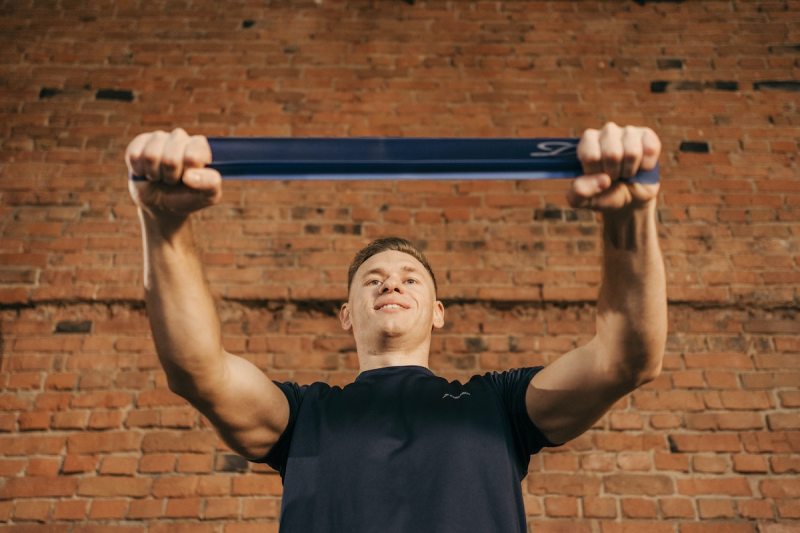
Resistance training challenges you physically and mentally, helping you build strength and tone. Dumbbells and barbells are often preferred, though bodyweight exercises like planks and pushups are also popular. Resistance bands may not look like much. However, the fitness version of rubber bands is a worthy addition to your workout toolbox. The versatile bands are thin enough to fit even in a smaller home. However, even sprawling fitness studios and gyms often have resistance bands on hand.
There’s good reason — one 2019 study showed resistance bands were about as effective as standard gym equipment for building strength. Bands offer other benefits, too. You can control the resistance in a workout based on where you hold the band. The lightweight nature makes resistance bands ideal for people cleared to resume working out post-injury.
Resistance bands can give various parts of the upper body a workout, including the triceps, helping you gain mobility in your arms and functional strength for lifting all the heavy items in your home. Grab a resistance band and give these six moves a try.

What do the triceps do?
A major upper-body muscle group, the triceps run down the back of your arms from the shoulders to your elbows. Without the triceps, we wouldn’t be able to extend our elbows. You may not think much about reaching to grab a can high up in a kitchen cabinet or bend your arm to button a shirt in the morning. You can thank your functioning triceps for that.

6 resistance band workouts to tone your triceps
The biceps are located at the fronts of the arms and therefore, often get more attention on arm day. However, strengthening the triceps is essential for building functional strength and preventing upper-body injury. Resistance bands can help you do both, allowing you to build definition without bulk.
Tricep kickbacks
- Loop the resistance band underneath your feet and stand at the midway part. The feet should be hip-width distance apart.
- Hold the resistance band in each hand. Bend arms at a 90-degree angle with elbows grazing your sides.
- Bend at the knees slightly and hinge forward at the hips.
- Keeping the back straight, extend your arms straight behind you. Stop before you lock the elbows.
- Slowly return to the start.
- Repeat 10 to 20 times for a total of 3 to 5 sets.
Overhead extension
- Stand with one foot less than hip-width distance in front of the other.
- Loop the resistance band under the feet. You should be standing around the midway part.
- Grab an end with both hands, looping it around your hands to add more resistance.
- Pull the arms overhead.
- Slowly return to the starting position.
- Do 10 to 20 times for a total of 3 to 5 sets.
Cross-body press down
- Anchor the band on something steady overhead, such as on a pull-up bar. (A sturdy closet rod also works.)
- Position yourself on the side of the bar, about a foot away. Your left hand should be closest to the bar.
- Bend your right arm at the elbow and grab the band. You want your hand facing your body, a smidge below the shoulder.
- Pull the band across the body with your right hand. Stop when your arm is straight down by your side.
- Slowly return to start.
- Do 10 to 20 reps. Switch sides.
- Do 3 to 5 sets on both sides.
Reverse grip pull-downs
- Anchor the band above your head, such as a pull-up bar or closet rod.
- Keel on the floor about a foot from the bar.
- Grab the band, leaving both palms facing you.
- Keeping the arms close enough to your sides to graze the body, pull the band down.
- Stop when your arms are bent at a 90-degree angle, and elbows are next to the hips. Squeeze the shoulder blades and triceps.
- Slowly return to start.
- Do 10 to 20 reps 3 to 5 times.
Pushups
- Wrap the resistance band around the body directly underneath your shoulder blades.
- Kneel on the floor in a plank position with wrists directly under the shoulders and back straight. (You can modify the move by placing the knees on the floor. Keep the lower back from caving in.)
- Lower the chest to the floor as you would for a regular pushup.
- Return to start.
- Repeat 10 to 20 times for 3 to 5 sets.
Pull apart
- Kneel or stand straight with feet hip-width distance apart.
- Grab the band with both hands, palms facing down, and fingers toward the wall.
- Where you put your hands depends on the resistance you want. However, hands should be in one line with the shoulders when you bend your elbows straight in front of you. The elbows should be just below the shoulders.
- Move at the elbows, keeping shoulders static as you extend the arms. Squeeze the triceps.
- Slowly return to start.
- Repeat 12 to 15 times for 3 to 5 sets.

A quick note on resistance exercises
Though resistance bands allow you to control resistance and are often recommended to people returning from injury, it’s important to discuss any new workout with the doctor helping you manage your care. Your doctor can tell you when you can return to working out and which exercises are safe and to avoid (at least temporarily). Additionally, as with any training, form is crucial in preventing injury. A personal trainer can help you perfect yours so you get the most out of your workout.



